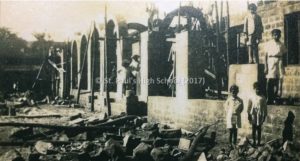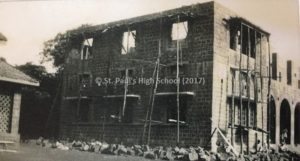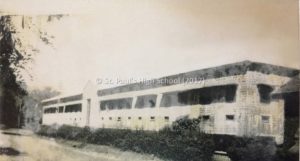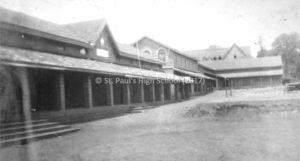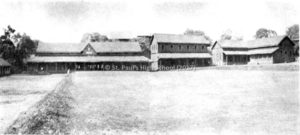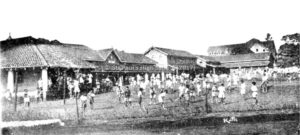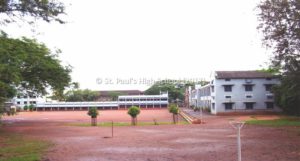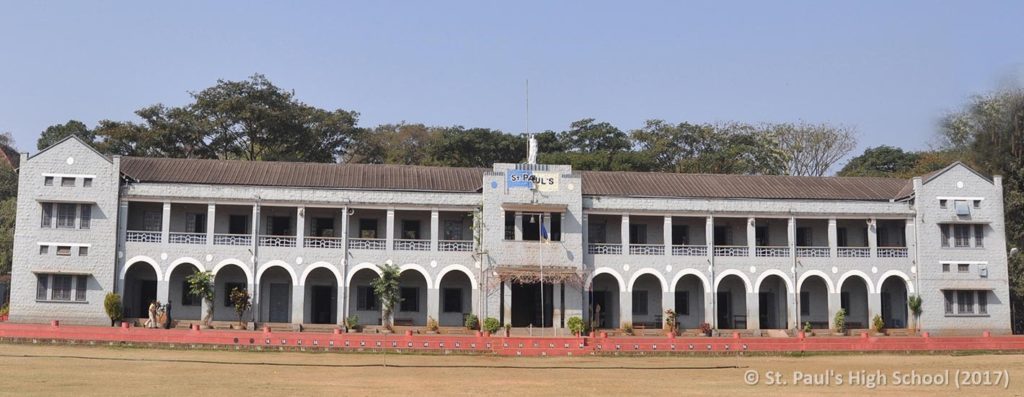
St. Paul’s High School has had a glorious past, with a legacy spanning 160 years of service and dedication to society, by not only the Founding Fathers – Jesuits, but also the dedicated Teachers who put their heart and soul into their noble profession.
160 years is a long time in the life span of any human being. However it is not a very long time in the span of an institution. St. Paul’s is one such institution that has stood the test of time, and lived to turn Boys into Men; men who work for the society, and contribute to the development of society at large.
Initial Foundations
Before the conquest of Belgaum by the British on 12th April 1818, the Christians of Goan origin who resided there were being visited occasionally by Portuguese Carmelites from Khanapur. One of them, Frei Clemente Mãe Dolorosa, stationed himself in Belgaum when a Regiment of the Brish Army was placed there in 1823. His immediate successor, however, suddenly left the place and went away. The British soldiers appealed to the Vicar Apostolic of Bombay in 1830 and from then till the official arrival of Jesuits in 1856, the station was ministered to by Carmelites owing allegiance to the Ordinary of Bombay. Fr. Patrick Sheehan, SJ looked after the place for a year (July 8, 1849 – June 1, 1850) and began extending the chapel of Our Lady of Mt. Carmel constructed by Frei Clemente at the site of the present High School building. The work was completed by Frei Maurice who, according to Bishop Hartmann who visited Belgaum on 10th March 1851, also began the construction of a school with separate classrooms for boys and girls. It is, however, not known when the building was completed and when the school was actually started.
The Beginnings of the School
St. Paul’s High School has had a chequered career. Its origin, although very humble, is lost in the haze of unrecorded history. Possibly, and to all appearances, very likely – it began as a parochial school for the children – boys and girls – of European troops stationed here. Tentatively, we may put down the year of its beginning as 1856, when the German Jesuits definitely replaced the Carmelite Fathers in Belgaum.
The School had a very humble beginning. The Fathers made the school not merely a place for the education of the children but also a community centre, around which the intellectual and cultural life of the people could revolve. The exact date of its founding has been lost in oblivion, but it seems to have been started as a small school attached to the Church of Our Lady of Mount Carmel or what was popularly called St. Mary’s Church during the time of Fr. Charmillot SJ, an Austrian Jesuit of the German Province.
On 8th March 1854, the Deccan portion of the Bombay Vicariate was entrusted to the Jesuits, but it was only on 16th February 1856, that Fr. Henry Charmillot, was able to take charge of the military chapel and of the little school which was being run by the Sodality of the Holy Angels. In all probability, at the initial stage, the classes might even have been conducted in the corridors around the Church.
From these humble beginnings, St. Paul’s High School has over the years grown to be what it is today. Not merely have the number of students and buildings grown, not merely has the name and the buildings changed, but the type of education given and the whole outlook of the school are quite different. And yet, through all these changes, St. Paul’s has in some ways preserved and even embellished its pristine purpose, the original goal of its founding fathers.
The School was one of the many works of charity, which includes the lepers home and the poor home, started by Fr. Charmillot under the auspices of the St. Vincent de Paul Society. This is why many claim that the school was first called “St.Vincent de Paul School.” However, we have no written evidence to prove that.
The earliest written correspondence with regard to the school refers to the “Roman Catholic Convent Schools” to differentiate the school from the Regimental School and the other Christian and non-Christian Schools of the town. Right from the start there were separate schools for boys and girls and according to Government Regulations even separate classes for Europeans and Indians or Anglo-Indians, the latter being referred to as natives or Eurasians. The classes were conducted separately for the two groups, with a master and teacher for the European boys and girls and a master and teacher for the Indian or Anglo-Indian boys and girls.
It gradually developed into a primary and then into a middle school. However, as happens in village schools today, the drop-out rate of the school was very high, so that within about 10 years the schools completely or very nearly closed down. About 1860 or 1862, for some reason, the Girls School ceased to exist, and in 1866, the Boys School too shared the same fate. In 1866-67, the Religious Congregation of the Daughters of the Cross were called and entrusted with the education of girls, under the supervision of the Jesuits. This eased the burden on Fr. Salinger SJ, the then manager, who had to manage two schools until then. This Convent School was registered on 3rd November 1868, and began to receive grant-in-aid. Under the Sisters’ care, the Convent School increased from 16 to 50 pupils.
In 1869 the records say there was a daily attendance of 66, of whom 17 boys and 37 girls sat for the examinations. The grant in aid of Rs. 537/- and school fees were entered under the name of Convent School, and no mention is made of the appellation of boys school. It seems, therefore, likely that up to the year 1869, the German Fathers had two separate schools under one management and under one name – Convent School. On the 14th of September 1869, Fr. Salinger, bought a house that was in the compound of the Church of Our Lady of Mount Carmel. Under the auspices of the St. Vincent de Paul’s Society. The building was used temporarily as a free library which was especially patronized by the British Soldiers in their free time. This house was later transformed into a Boys’ School and given the name of St. Paul’s, or St. Vincent de Paul’s School. Similarly a new house was bought also in the compound of the Convent and destined for the girls school. Somehow, or the other, the school seemed to have stuck to the name of Convent School.
By 1871 there were 101 (30 Europeans, 30 Eurasians, 39 Portuguese (Goans), 1 Native Christian and 1 Brahmin) children on the rolls so that the school was bursting at the seams. So new premises were found for the boys, in one of the bungalows that was situated in the present compound of St. Joseph’s Convent. But this too proved too small so that in 1873 the boys school was finally and definitely shifted by the Fathers, back to the Church compound and was located in what many generations of boys came to call the “yellow building” and was referred to by the Fathers as “The Parthenon” because of its pillared structure.
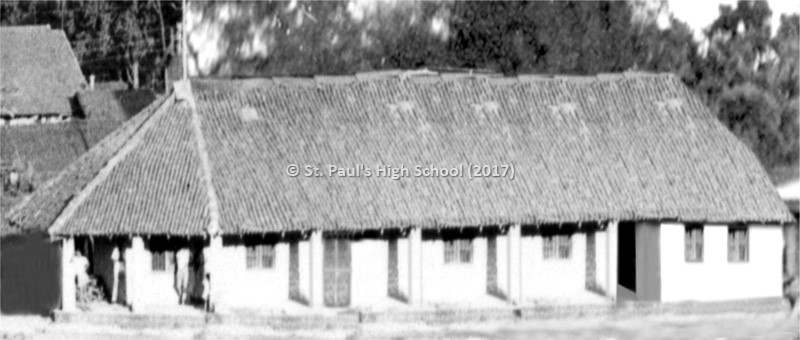
This final transformation of the school to its present premises and form was the work of Fr. Wilhelm Adams SJ. In 1873, Fr. Adams built the new school in the Church compound. He probably pulled down the house which was adapted for the boys’ school and also the soldiers’ library. This library continued to function in the new building. This first building of St. Paul’s School provided room for the laboratory and upper classes.
“It is noted,” says an ex-Headmaster, “for its profusion of columns which cause it to look like a miniature Greek Temple,” among the new Jesuits, it was known as, “The Parthenon.” He did such a thorough job of rebuilding and strengthening the building that it would have been standing on its high plinth even today, had it not been pulled down, (in 1964) just to make place for the present primary building.
The number of pupils on the rolls fluctuated between 50 and 100, being dependant on the military population of the station. In 1876, it had 100 children – boys and girls. When the British troops were withdrawn from Belgaum, the numbers dwindled down to a mere handful. In 1881, the Daughters of the Cross were withdrawn from Belgaum and a teacher Ms. Mary da Costa and her sister were put in charge of the girls’ school and the boarding.
In a few years, especially around 1877 epidemics like plague, cholera, dysentery and typhoid began to ravage Belgaum, Dharwad and Hubli districts. The result was that there were many casualties since scientific methods of treating these diseases, simple hygiene and antibiotics were unheard of. Many children also fell victims to the epidemics and malnutrition. So terrible were these tragedies that Government Resolution 2144 of 1896 would later read : “All School managers should be informed that in case of any outbreak of cholera or other disease which may render it advisable to close the school, the Civil Surgeon or nearest Government Medical Officer should be consulted before the children are sent home.” However, this sparked off in the minds of the managers the idea of an orphanage to look after these little homeless orphaned destitutes. A number of the under-nourished died within months but those who survived and recovered were put into school.
The 12th of March 1878 was important for St. Paul’s. On that day by letter No. 5611 the school was registered with the Government for annual grants after the inspection of the school certified that the standard of the school warranted grant in-aid.
In 1890 because of certain political changes in Europe, the school changed hands from the German to Portuguese Jesuits. On the 16th of February of that year, Fr. Joseph Manual Gonsalves, Fr. Joseph Pires Antunes and Brother Stephen Gonsalves took charge of the school and the church in Belgaum from Fr. J Nuckel SJ. The year also marked a steady decline in the strength of the schools, and on the 7th of April 1890, the Mission was officially made over to the Portuguese Jesuits.
For some years, Fr. Joseph Gonsalves worked indefatigably to bring up the school. He worked against many odds, but the inspector in 1907 summed up his inspection report thus “I have pointed out a number of defects but on the whole I formed a favorable impression of the school which is doing useful work.”
Soon, the Religious Congregation of the Sisters of Charity of Canossa were also brought in to take charge of the education of girls. For some years, the Fathers continued to give the Sisters a helping hand until they were able to manage things by themselves.
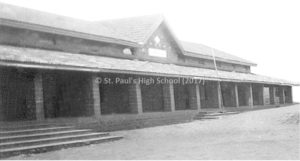
To improve the numbers in the school, a boarding house was opened in November 1907 under the super-vision of Mr. Sebastian Trinidad Gomes. He had 17 boys in his charge. In 1908 an orphanage was definitely opened with 12 orphans. By 1910, the school could no more be managed in the existing space, so gradually plans were made and executed for a new building of 3 rooms to be put up. The building was inaugurated on the 5th of November 1912. The Commissioner, Sir Sheppard, presided over the function, with General Fry, who was also present. The building cost Rs. 12,600/-. This 1912 building as you see is still standing today. With the inauguration of this building the school definitely took on its present name “St. Paul’s High School.”
On 7th January 1913, the boarding house was taken over by the Fathers to be managed and supervised by them. The results in the school improved and the inspectors spoke highly of the work done. The Inspection Report of Mr. O. A. Dudley has this to say in 1913 : “I am glad to note a distinct brightening up in the general intelligence and demeanor of the pupils. The number on the rolls has actually risen from 145 to 167, more than double the increase of the last two years. This speaks well for the reputation of the school.”
In the meantime, St. Mary’s Church began to crumble and became unsafe for habitation so that the Cantonment Authorities ordered it to be pulled down in 1914.
The red letter day of St. Paul’s came during the year 1915-16 when the first set of St. Paul’s students appeared for the Matriculation Examination of the Bombay University. Of the 7 sent up, five passed among whom was the only girl who ever passed out through this school. She was Miss Mary D’Silva.
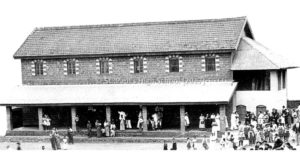
In 1917, St. Paul’s was permanently recognized as a High School by the Bombay University. The whole boys school was seen in about 1918. With this, and the reputation the school acquired through its good results, the number began to swell even more, with the result that Fr. Joseph Fias, who took over as Principal decided in 1920 to put up a 2 storied building to provide for more spacious accommodation as the inspection reports often remarked about the over-crowding of class rooms.
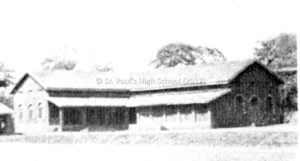
Fr. Joachim Lima SJ, took over as Principal and Manager from Fr. J Dias in 1921. In June 1922 he decided to put up yet another building in the form of an “L” to provide 2 extra classrooms and a study hall for the boarders. This building was inaugurated on 8th June 1924 and was pulled down in 1955 to make room for the present office block.
Fr. Joachim Lima stayed at the helm till 1928. On the 4th of May, the school rejoiced when it was publicly announced that their Principal, Fr. Joachim R Lima SJ, was appointed Archbishop of Bombay. Yet all were sad when he left, for the school lost in him a clever man and a wise administrator. However in far off Bombay he always remained a friend of St. Paul’s and considered it his home.
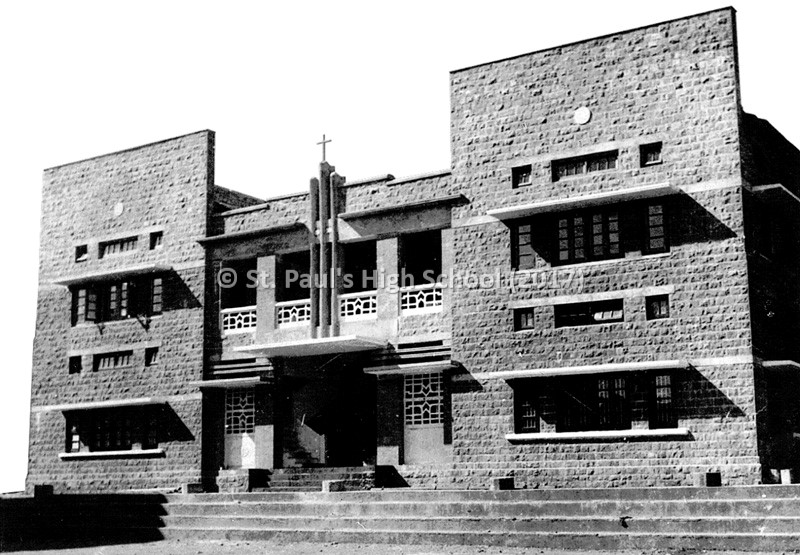
With good reputation built up by the school, more and more students sought admission. Even though many were turned away, yet the classes were full. In very large measure the reason for this success was due to the long standing staff, both Jesuit and lay and especially to their total dedication to their students. There was a systematic approach to problems, regular checking of work done and a total dedication to the students. Some inspectors were so struck by it that they remarked, “I have never seen such a thorough going effort to set writing of the school along the right lines…. This is the first school I know to reduce corrections to a uniform system…. In the upper classes the boys display a really serious attitude towards their work… the discipline is sensible and firm.”
No ex-student of the school will ever forget the total dedication of the staff. It was because of this, their students were prompted to write, “Theirs was a labour of love. The salary was a pittance, irregularly paid. Perhaps the compensation they got was from their pupils who respected their masters, did their duty conscientiously and results were generally satisfactory.” “They belong to a bygone age when duty, services and sacrifice were not mere words, but a way of life, to a race of people who were larger than life” wrote another. Truly, one could sum up their whole life by saying, “Teaching for them was a vocation not a profession and to it they dedicated themselves heart and soul.”
St. Paul’s progressed from stride to stride. With more and more people migrating to Africa and the Middle East in search of jobs, the number of boys in the boarding began to grow till there were nearly 100 boys at one time. And yet those were the days when Fr. Sylvester D’Souza SJ could handle the whole boarding single handed when necessary and never was there any trouble. Not merely were the boys bigger and more responsible, but the educational climate of the school was conducive to study. Those boys who were not interested in studies or could not make head-way in class simply left school and soon found gainful employment. The rest who stayed behind were serious about doing well in their studies because they knew that neither money nor a political god-father could get them a place in a professional college. It went strictly by merit. Those who worked hard knew they could get recognition in the form of prizes and honorable mention. The inspector, Mr. H. Davies, wrote with great pride in 1936, :The upper classes are extremely well graded and taught, the School’s record in the Matriculation Examination being one which over a long period has entitled it to respect…….. The percentage of passes (24 sent up and 20 passed) is therefore 83% as against the University general average of 35% and the school stands first among the English Teaching Schools of the presidency. It has earned distinctions at ten times the average rate for the presidency and has once more secured the Latin Prize.”
How far these praises bestowed on the school were justified we may judge from the following facts. Out of 297 boys sent up for the University Examination between 1927 and 1940, 226 passed, 71 securing distinctions in Mathematics, 43 in Science, 22 in Second Language, including 2 Latin Scholarships, 4 in History and Geography, and 1 in English. The percentage of passes therefore, for the 14 years was over 76 and the percentage of distinctions for every 100 passed was 62.
However, this homely, congenial atmosphere began to change with the increase in numbers. Permission was applied for to expand but was refused by the Cantonment Board for the following reasons, ”The application to be rejected, on account of the congestion which already exists in certain parts of the Cantonment due to influx of the pupils at present attending St. Paul’s School and for reasons of public health. Mr……. desires that his dissent be recorded as the application was submitted to meet the requirements of the educational authorities.”
To cope up with the growing numbers, two rooms were rented out on the other side of the road, where the lower classes were conducted. Experiments, projects and improvements in the educational work continued. The School acquired a German epidiascope. On 12th August 1941 the first St. Paul’s Annual was published. Although it came out erratically thereafter, the articles were of high standard.
The pressure for expansion still continued to mount up so that on 31st January 1946 permission was finally accorded by the Cantonment Board for a new building, the present secondary wing. The foundation stone was laid on 1st April 1946 and the building was inaugurated on 2nd November 1947 by the then Bishop Valerian Gracias Auxiliary Bishop of Bombay. This expansion gave the school a new lease of life and a fresh impetus. The ”yellow building” gradually came to be abandoned. The class rooms across the road were given up. Students moved into more spacious and airy classrooms. The school took on a more modern air.

Glimpses from the Construction of the Secondary Building
The building of the secondary block also gave the principals a chance of dismantling all the graves in the school compound and in the late 40’s the play-grounds were levelled to their present shape with the slope between the grounds being used for a natural stadium. With this, no more did the cricket lovers have to go to the Railway Station ground or to the Union Gymkhana to enjoy a game of cricket.
In the 1950s, the political changes taking place in the country and abroad began to have an impact on the school. With the blockade of Goa since 1954-55 the boys from Goa began dwindling down. With the pressure on Indians in Africa and the Middle East, many families permanently migrated to the West. So the population of the boarding changed. There was an influx of land lords’ children and from families outside Belgaum. The number of parents beating on the doors of St. Paul’s also began to increase. The number of students swelled. There were 1200 then and 1500 later, till there are practically 1800 today.
The mid 1950’s also saw the birth of St. Paul’s Kindergarten, by Fr. George Rego SJ, under the motherly guidance of Ms. M D’Lima, Ms. Pandit and Ms. Lobo. Gradually the demand for admission grew and it was turned into an independent institution, with the name “Sunbeam Nursery.”
In 1956 the school celebrated its Centenary. The office block was inaugurated in time for the centenary. At this time the school took on its present system of houses, inter-house matches, elocution and singing competitions and all such events that make up the day to day run of any school.
But this time major changes took place. With the re-organization of States in 1956, the school gradually came under the Karnataka Secondary School Board. There were also many other changes which affected the school, some for the better, some for the worse. The school saw a rapid succession of Principals at one time six in as many years. But the lay staff, especially in the High School section, remained the solid rock foundation on which the traditions of the school were carried on. Their permanence brought stability to the school in all the changes.
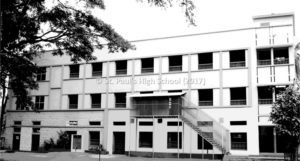
In 1964, the “yellow building,” the first building of the school was pulled down. No more would there be a scout den, no more would there be the many pillars around which the boys would play hide and seek. In its place came up the modern and more prosaic primary building.
In 1966 with growing numbers in the hostel, the new hostel was built and the football field improved. The school boys now had ample place to run around and play, enough room to spend all their pent up energy.
On 11th December 1967, after the Koyna earthquake and its after-shocks, the 1912 and 1924 buildings developed major cracks. Gradually they became so unsafe that they could no longer be used. Fr. Walter D’Souza SJ, the then Principal decided to replace these buildings, but faced problems from the Cantonment Authorities who did not give permissions. The plans were put off for almost 2 decades, until the permission was granted by Central Government.
One more step taken was the opening of the Pre-University Classes in 1969. So for a time the name of the school changed to “St. Paul’s Higher Secondary School.” Once again girls were seen on the campus, as the classes were mixed. But this venture did not last for very long. In 1974 the P. U. C. was closed because our own students were more enamored with the free college atmosphere, besides they did not want to run around for admission to the Graduate courses after they passed their P. U. C. The management, on the other hand, faced various administrative and financial problems. The syllabus was too easy to keep students gainfully employed, not having enough to do made for a change in climate among the students. Their care-free and couldn’t-care-less attitude began to filter down to the students in the High school. The last straw to break our backs was the fact that quite often grants ware paid by Government and next year were recovered after they had already been spent, because it was claimed that the school was overpaid. Furthermore, since the number of students was small, only part time lecturers were allowed, and this did not attract the best talents. So with the closure, St. Paul’s regressed to its old status of being just a High School once again. All agreed that though this was a crying need in the town, yet the PUC should be run on a different campus and with a different tone and atmosphere from a high school.
In December 1981, the school celebrated its 125th Jubilee. It was the time when Fr. Agnelo Pinto SJ was the Headmaster. The staff, students and alumni had a good celebration and it was an occasion to meet old friends. During that time, Fr. Agnelo put in a huge effort to go through all the rich records of the school, many over a century old, and create an archive of history, one that we refer to even today.
Somewhere during the year 1987, the Central Government granted the permission to replace the 1912 and 1924 buildings. It is significant to note that the school had to wait for over 11 years to get the permission for this, from the time they applied. This shows the kind of hurdles faced by the school management, over the years. Very few know that though St. Paul’s has benefited from being on the border of the old Cantonment area yet this has also been one of our biggest hurdles. The school has been on these premises long before the Belgaum Cantonment was formed, as is testified by the authoritative Mehta’s report of the British government. St. Mary’s Chapel, the original building on these premises was built in 1823 before the boundaries of the Belgaum Cantonment were delineated. Yet the Cantonment authorities, both local and sometimes central, have been the biggest stumbling block in expansion. For instance, the 11 year wait to get a single building permission to rebuild buildings that had been cracked in the Koyna earthquake. Very few know that this was also one of the reasons why St. Paul’s could not go ahead with her plans of expanding the P.U.C. that had been started.
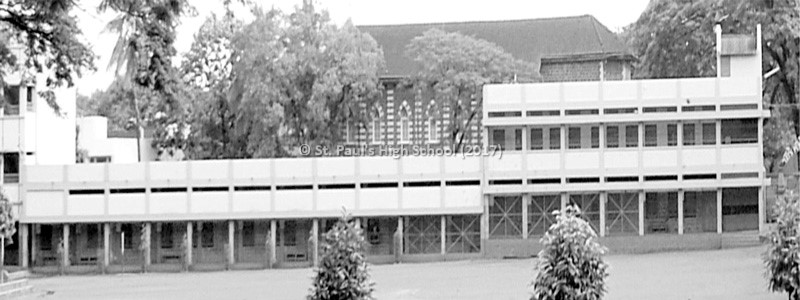
In around 1992, Fr. Jacob Carvalho SJ took charge of the school. Being a visionary who worked from the grass-root, he was the one who shared the best rapport of these times with the staff and students alike. During his tenure, was the transition period for the world, where technology randomly improved at a high pace; and Fr. Jacob tried his best to keep up with the growing trends, in spite of having limited financial resources. It was the time when St. Paul’s received its “Computer Room,” and the students of Standard X were often given an hour a week to practice their skills. He was loved by everyone so much that he became the only Principal in the history of the institution to serve for 12 continuous years, and the second longest serving Principal of all time, being preceded by Fr. Agnelo Pinto who served for about 14 years in total. Such was his love for the school, that when the news of his sudden transfer came in August 2004, many X standard students got together and wrote a petition to the Goa Provincial, requesting him to keep Fr. Jacob at St. Paul’s for another year, until they pass out.
Time passed, and in 2006, the school celebrated its 150th Jubilee Year with a lot of fun and frolic. It was the time when Fr. Agnelo Pinto SJ had come back for his second stint as the Principal of St. Paul’s. Along with staff, students and a huge effort of alumni, the celebrations were grand and paved the way for a lot of future developments, of which, the present “Paulite Link” and the alumni association “Paulites of Belgaum Worldwide,” are by-products.
Over a decade later, the seeds sown by Fr. Agnelo SJ during the 150th year, made for a grand celebration of the 160th Jubilee year, with a great amount of dedication from the Alumni Association, the PBW, and the Alumni Magazine, the Paulite Link. It witnessed a huge participation of 3638 Alumni on the day of the Grand Reunion, the 17th of December 2016.
Today, this 160-Year old school, has over 2000 students and continues to train and educate them in the best traditions to develop their young minds and hearts to face the problems of the outside world.
Glimpses from the school Grounds
St. Paul’s Today
They all have dreams, dreams that need to be fulfilled, so they stand in serpentine queues and convert the area around the school into a sea of humanity, to get an admission form. Desperation, apprehensiveness and nervousness writ large on their faces and hope filled hearts they come back with their form duly filled.
Why does St. Paul’s school continue to enamor the people of Belgaum? Why are Paulites constantly haunted with nostalgic memories and long to return to their alma mater? Why does the school still stand like the Rock of Gibraltar in spite of being bombarded with criticism from time to time? Well the writing on the wall is clear. St Paul’s stands second to none. It is what it is, with its failures and success. Old foundation and new constructions, the incorrigible and well behaved students.
The regular school days are as normal in its working as any other school. Boys trying to make a hurried entry before the Silver Gates close, which is a glaring indication that they are late. The sound of the bell synchronizing with the footfall of the students as they run joyously, shoving and pushing each other towards the assembly ground. The others who are late stand sadly by the gate awaiting their punishment and make a desperate attempt to blame the rickshaw driver for the delay.
The sound of the bugle has not diminished in its intensity although the physical stature of the buglers have. The classrooms minus the teachers are always filled with boy’s chatter and, as usual, during the recess there is pandemonium and a cacophony of sounds that could definitely give even the crows a migraine. Students are still engaged in that age old battle for their rightful space on the bench. The school bag still plays a Nobel role in officially demarcating the line of the Great Divide between the two bench mates. The petty fights and brawls still take place and the spectators urging them on have the same enthusiasm as their predecessors. There are some who still carry out their little acts of mischief while majority enter the rhythm of creation by appreciating little things of nature around them.
At lunch time one can still witness some generous souls feeding the crows and eagles with eagerness not because they are interested in ornithology, but simply because mum has packed the Tiffin with healthy, but unpalatable vegetables. You still find that rare lot, who prefer tucking into their friend’s Tiffin consisting of dal and roti, while they have a gourmet’s delight packed in theirs.
CCTV’s have been installed in every classroom and in the corridors. At the CBI headquarters (Rev Father Principal’s office) mysteries are unraveled on the screen. Students who love to display their aeronautical skills with their indigenous paper missiles which can compete with the sophisticated drones for their accuracy have a regretful landing when Father Principal uses the CCTV to nab the culprits. So now, all those technological entrepreneurs think twice before getting enmeshed in unwanted histrionics. It is hilarious, when out of the blue; Fr Principal’s voice breaks the silence to tell a student ten blocks away to correct his posture before prayer, thanks to the CCTV.
St. Paul’s now has a superb lunch shed. Thanks to the PTA members who left no stone unturned to get the consent needed to put up this structure. St. Paul’s will always be grateful to all those parents who helped to fund a long standing suggestion with brick and mortar and the outcome is a majestic structure.
Boys will always be boys. All the Do’s and Don’ts have no place in their hyper active minds. They try out every acrobatic feat under the sun. The lucky few get away with it, but the unlucky ones have a mighty fall, and end up with broken bones. Believe it or not when they are back in school, they are at it again with a never say die attitude, only to break another bone. They seem like accidents waiting to happen. Here at St. Paul’s we haven’t yet started taking a census of broken bones. If we did there would be innumerable names etched out in the book of records. You may call it carelessness, but for these boys, they are little acts of bravery and innocent display of strength.
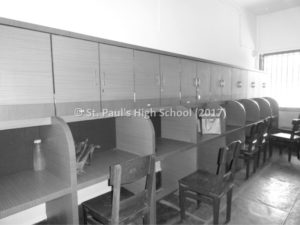
Communication is at its best when cryptic messages are passed around on tiny bits of paper. Teachers usually cut off the network and intervene only to avoid a face-off between the predators and the prey.
We now have a beautiful grotto near the Silver Gates and dear Mother Mary keeps a watchful eye on all the students who make their entry and exit. She watches over them while they enjoy rollicking moments and while they plot and plan and carry out their pranks under the canopy of the trees.
Our staff room has just had a face lift. It continues to retain its old charm, but at the same time wears its new attire with aplomb. Our swimmers, athletes and football players are a force to reckon with as they continue to script a triumph at the State and National level.
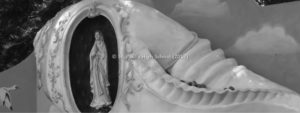
For those plagued with doubts about the standard of the school, I have a message to convey: No matter how maliciously a few may conspire to strip the undisputable glory of St. Paul’s, we continue to emerge victorious and earn our place in both sports and academic field.
Well, the school continues to educate the good, the brainy and the naughty and we continue to respect their unique differences and in doing so we continue a build an album of memories that never fade.
At the end of the day, when the sound of the bugle fills the air, we thank the Lord that we are part of this Great Institution.

